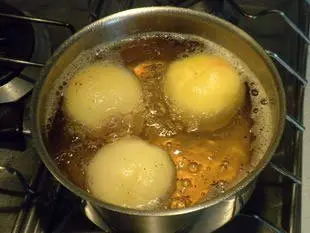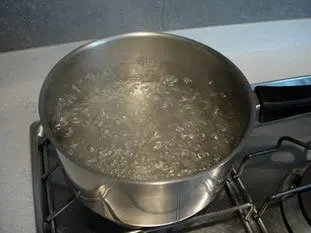The blog of cooking-ez.com
Sugar syrups
A syrup is simply water and sugar, brought to a boil to mix them well, and then left to cool before use.
The difference is in the ratio of water to sugar, or in other words, how much sugar do you put in how much water?
Of course, starting with 1 liter of water, all weights of sugar are possible, but there are still 2 main proportions very used.
It is used as a base for fruit sorbets, to soak babas or cookies, or to shine the top of a pastry or pastry.
It is used to poach fruits.
Syrups can be kept in a closed container in the fridge, away from the air. They can also be easily frozen.
In summary: A syrup is a mixture of water and sugar in variable proportions, the 2 most used proportions are 1 liter of water for 1 kg of sugar (heavy syrup) or 1 liter of water for 500 gr of sugar (light syrup).
The difference is in the ratio of water to sugar, or in other words, how much sugar do you put in how much water?
Of course, starting with 1 liter of water, all weights of sugar are possible, but there are still 2 main proportions very used.
The heavy syrup
It is a ratio of half and half, 1 liter of water + 1 kilo of sugar. The syrup obtained, quite thick, is called "syrup at 30" by pastry chefs.It is used as a base for fruit sorbets, to soak babas or cookies, or to shine the top of a pastry or pastry.

The light syrup
It is a different ratio, 1 liter of water + 500 gr of sugar. The syrup obtained, quite light, is called "syrup for 60" or "poaching syrup" by pastry chefs.It is used to poach fruits.

How to make it?
It's very simple, you mix sugar and water in the desired proportions in a saucepan, you bring it to boil for 1 minute, you let it cool and it's ready.Syrups can be kept in a closed container in the fridge, away from the air. They can also be easily frozen.
The degree of a syrup
As indicated above, the names sometimes refer to a degree, for example 30° for "syrup at 30", it is not a temperature, but an old measure of concentration, the Baumé degree (of the French chemist Antoine Baumé), which is obsolete but whose use, very approximate, still persists.In summary: A syrup is a mixture of water and sugar in variable proportions, the 2 most used proportions are 1 liter of water for 1 kg of sugar (heavy syrup) or 1 liter of water for 500 gr of sugar (light syrup).
Lasts posts
Wipe meats and fish before cooking
When you want to cook meat or fish, there's a very simple yet very important step to take before you even start: It's to dry, or wipe, each side of the meat or fish, sometimes called "dabbing" or "sponging". But why? And how? Let me explain.1,5195 April 14th 2024
Toss the salad
When you've finished preparing a salad, green or otherwise, it's usually time to add the dressing and toss. It's often said to "toss the salad", which means to season and mix. Is it easy? Not so easy...2,8575 March 8th 2024
Half milk, half cream
In a multitude of recipes, savoury or sweet, milk is used as the main ingredient, or at least as the main liquid ingredient. Milk is used instead of water, for example, because milk contains a proportion of fat, which adds roundness and softness to the recipe. This mellowness is very pleasant on...2,696 February 27th 2024
Cutting soft cheeses
As you may have already noticed, when you have to use a "soft" cheese in a recipe - their exact name is "soft cheese" - such as Camembert, Munster or Mont d'or, it's not easy to make anything other than thick slices.2,8165 February 20th 2024
It's spinning too fast!
When you need to grate or slice vegetables, you generally use an electric machine that does all the work: a food processor, a mixer with a "slicer" extension or similar. Are these machines really suitable? Generally speaking, yes of course, but there's one criterion that often poses a problem,...5,7815 November 12th 2023
Other pages you may also like
Candied fruits: don't get ripped off
Do you like candied fruit? You might like to nibble a handful or add it to a recipe, like a classic fruit cake or delicious Italian specialities like panettone or sicilian epiphany pie.53K 24.2 June 21th 2017
A few tips for effective kneading at home
When you have to knead dough for bread or some other recipe, you may well use a food processor or the type of machine known as a stand mixer. The best-known brands are Kenwood and KitchenAid. They are useful tools, but here are a few tips to help you get the best out of them.266K 23.7 June 23th 2021
The super powers of cornstarch
I start this new year by evoking an old product, that you most probably have in your cupboards, a white powder, often in a small cardboard package with a slightly outdated look, only the "gluten free" is relatively recent, it is simply cornstarch, hence its name of maïzena. It's used for a lot...8,349 January 14th 2022
Rosemary in recipes
Rosemary, as I’m sure you know, is a culinary herb, one of the famous French "herbes de Provence", and is very effective in bringing a real taste of the Mediterranean to any dish. The classic way to use it in a recipe is to add a sprig or two and leave it in during cooking as a way of...19K4.7 April 18th 2018
What is the difference between bakery and patisserie?
This is a question that you may well have asked yourself and which I will attempt to answer. In France the two trades of "boulangerie" (bakery) and "pâtisserie" (patisserie and confectionery) have always been quite distinct, but where exactly do the boundaries lie? .119K 14.1 February 7th 2017
Post your comment or question
Follow this page
If you are interested in this page, you can "follow" it, by entering your email address here. You will then receive a notification immediately each time the page is modified or a new comment is added. Please note that you will need to confirm this following.
Note: We'll never share your e-mail address with anyone else.
Alternatively: you can subscribe to the mailing list of cooling-ez.com , you will receive a e-mail for each new recipe published on the site.










